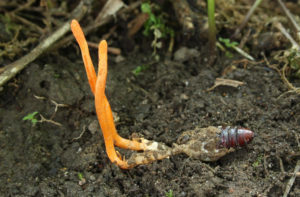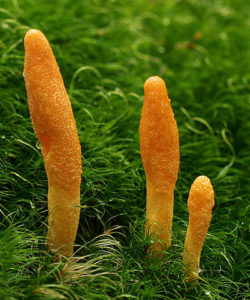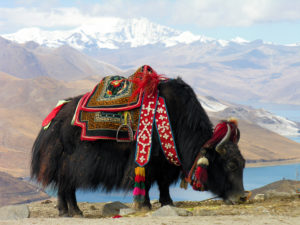Cordyceps sinensis is a very interesting medicinal mushroom that has been used for medicinal purposes in Asia for centuries. It is used mainly to restore lost energy and vigor and to stimulate a fatigued immune system acting like a general tonic for the body.
In addition to the English term “caterpillar fungus” there are other interesting names of this killer fungus. In Tibetan it is referred to as Yartsa gunbu. The Chinese name is dong chong xia cao (meaning “winter worm, summer grass”). The Latin name cordyceps means “club head”, and sinensis is “from China”. According to the recent DNA review of the genus Cordyceps, the new name for Cordyceps sinensis is actually Ophiocordyceps sinensis.
It grows only in the mountains of Himalaya, on the Tibetan plateau, at the altitude of 3,000-5,000 m in cold snowy marsh lands of China (Tibet), Nepal, India or Bhutan.
This fungus is also known for its unique way of reproducing. It sprouts from the body of dead caterpillar in the wild, entering the body of a live caterpillar while it is in the larval form of a large moth (Thitarodes spp.) native to the region. Upon infection from the spores, strands of filaments called “hyphae” begin to sprout from the spores that then leads to the death of the caterpillar. That’s a parasite with no scruples! The hyphae grow longer and multiply and develop into a relatively large stalk-like fungal fruiting body that emerges from the insect’s carcass after having sapped the caterpillar’s body of all nutrients thus killing and mummifying the remains. This horror movie action makes Cordyceps one of the coolest mushrooms around!

The killer fungus in action!
The fruiting body is usually up to 4 inches (around 10 cm) long and 0.3 inches (1/2 cm) wide. Unlike a typical mushroom, these are curved and finger-shaped like a small cane. They’re usually orange or brown. It can be a very important source of income for people living in rural Tibet.

Cordyceps sinensis – sprouting from buried caterpillars
BBC News reported a few years ago that some Himalayan villagers make their living by collecting the fungus along the mountainous regions of Tibet to sell to a Chinese market that can be as high as tens of thousands of dollars per kilogram. In fact, the money to be made is so lucrative that it resulted in multiple homicides as villagers from one region tried to prevent outsiders from cashing in on their limited supply. It was estimated that the price of Cordyceps sinensis on the Tibetan Plateau rose dramatically by 900% between 1998 and 2008 due to the demand from the Western hemisphere and Europe Today, in order to meet this demand, Cordyceps is grown in climate-controlled greenhouses within a grain-based substrate.

Tibetan mountains
Cordyceps fungus has a long history of use in traditional medicine in China and now worldwide. It has numerous bioactive compounds, including polysaccharides and nucleosides (organic molecules that will be converted into building blocks of the genetic material DNA) which have been studied for their broad range of biological activities. Its main constituents are Unsaturated fatty acids, Amino acids and Adenosine, Adenine, Uracil, Uridine and Cordycepin (3′-deoxyadenosine). It is usually standardized to 4% cordycepic acid and 0.25% adenosine (Metagenics). Cordycepin is known as a nucleotide analogue, due to its structural similarities to adenosine.
It is sweet in flavor, slightly warm in nature and in Traditional Chinese Medicine this fungus mainly manifests its therapeutics actions in the Lung and Kidney meridians (enhances Kdnney Yang and replenishes Essence, invigorates the Lungs, stops bleeding and dissolves Phlegm).
In the Western medical world, the health benefits of Cordyceps sisnesis are:
- Stimulation of the immune function
- General adaptogen, resulting in more energy, strength and stamina
- Anti-tumor properties (good for cancer)
- Anemia (builds bone marrow)
- Persistent cough (reduces excess phlegm and increases oxygenation in the lungs)
- General sexual tonic and libido/performance enhancer (“Viagra” of Asia)
- Reduces cholesterol, triglycerides, LDL, VLDl and increases HDL
- Improves Arrhythmia
- Improves Tinnitus
- Hypoglycemic effects (reduces blood glucose and benefits insulin resistence)
